Category: General

2025 Lucid Gravity has Tesla NACS port, gets Supercharger access Jan. 31
Lucid is ready to roll out Tesla Supercharger access for its 2025 Gravity electric SUV.
Lucid committed to adopt the Tesla-developed NACS charge port in November 2023, and said in September 2024 that the Gravity would get a NACS port sometime this year, shortly after the start of production. The automaker on Tuesday confirmed that every Gravity built for the U.S. market has a NACS port, with Supercharger access to go live Jan. 31.
The Gravity’s NACS port is located in the same spot as on a Tesla—the rear driver’s side of the vehicle—to facilitate easy use of V3 and V4 Supercharger stations. That’s a completely different location than the front left fender, where it had located the charge port in prototypes.
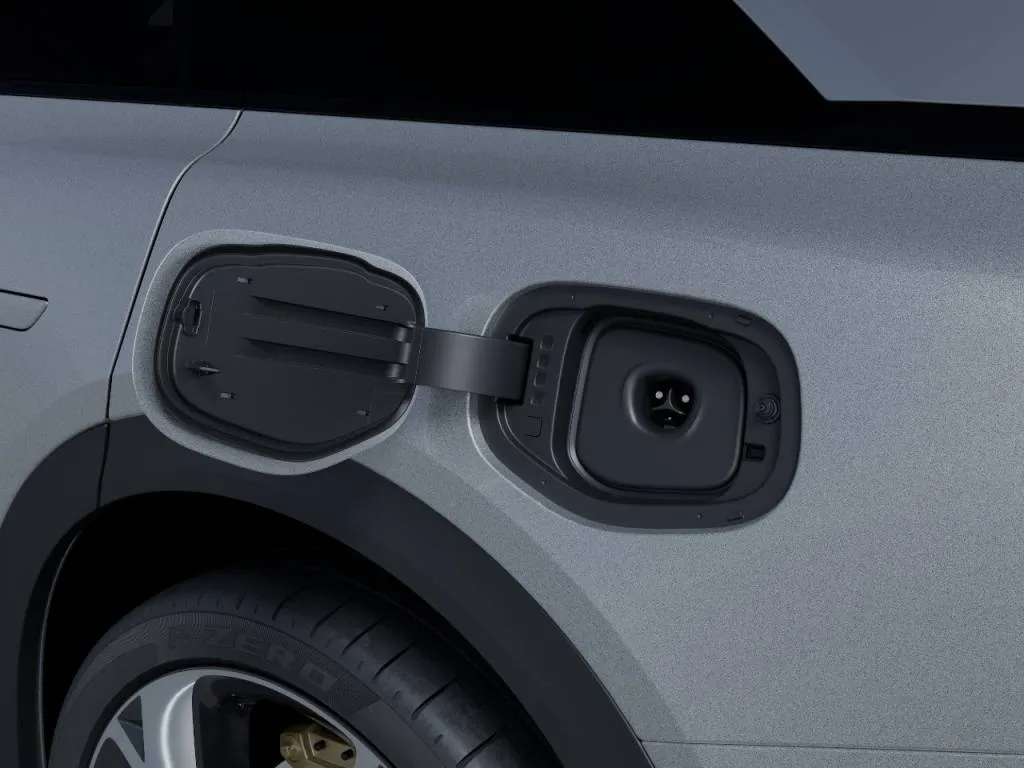
Lucid Gravity with Tesla NACS charge port
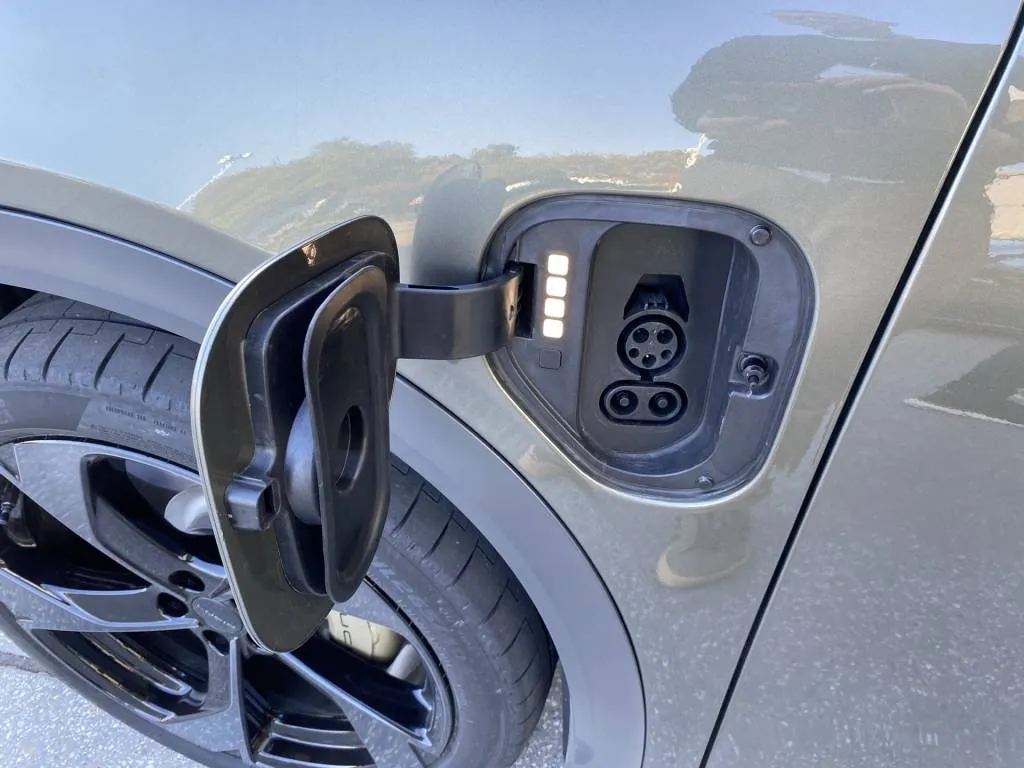
2025 Lucid Gravity Grand Touring
Lucid expects a sustained charging power level of 225 kw on 500-volt DC fast chargers like the V3 Superchargers and up to 400 kw with the 1,000-volt output of V4 Superchargers.
At peak charging rates, Lucid estimates that 200 miles of range can be added in less than 12 minutes at a peak 400 kw—a significant improvement over the 15 minutes it had previously claimed with a 350-kw connector.
Lucid also confirmed a 123-kwh battery capacity, with cells supplied by Panasonic but with what Lucid claims are chemistry updates compared to cells used in the automaker’s Air sedan, returning an estimated 450 miles of range.
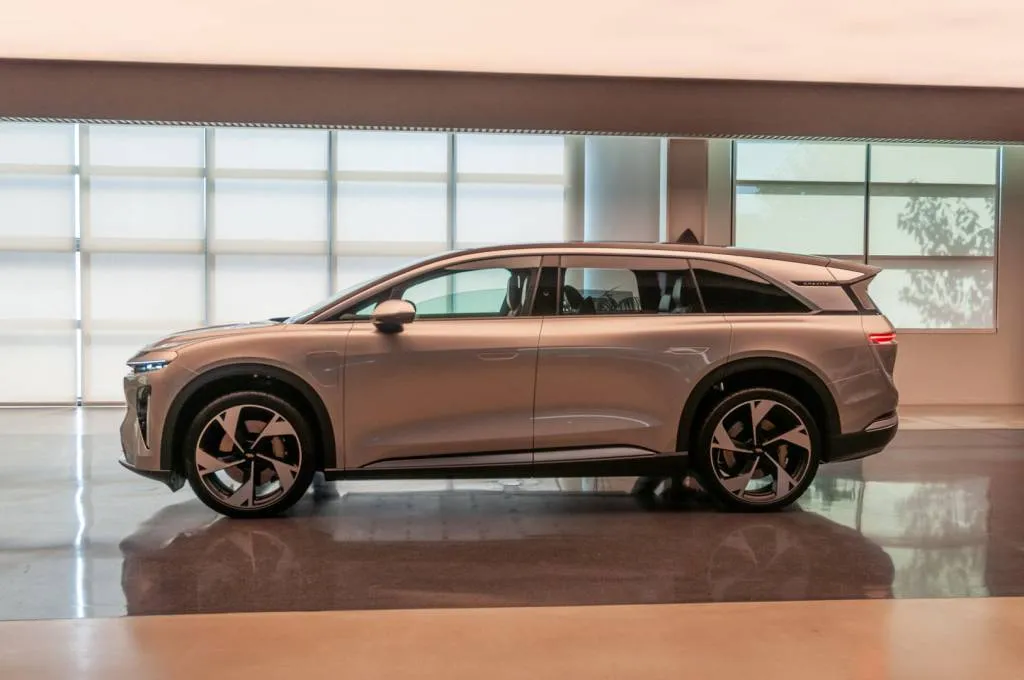
Lucid Gravity
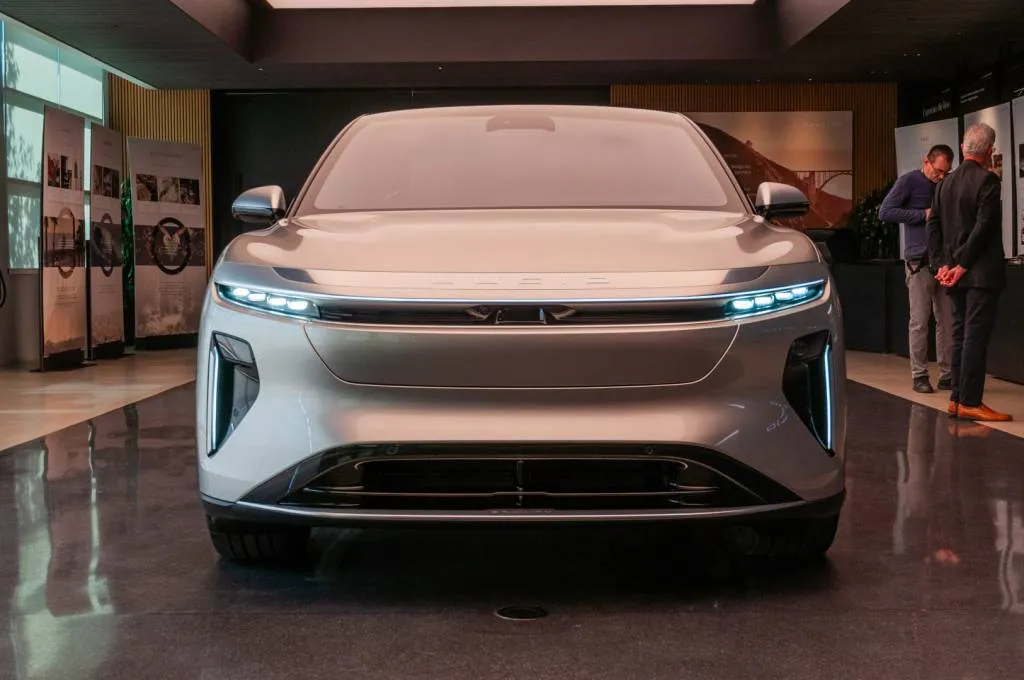
Lucid Gravity
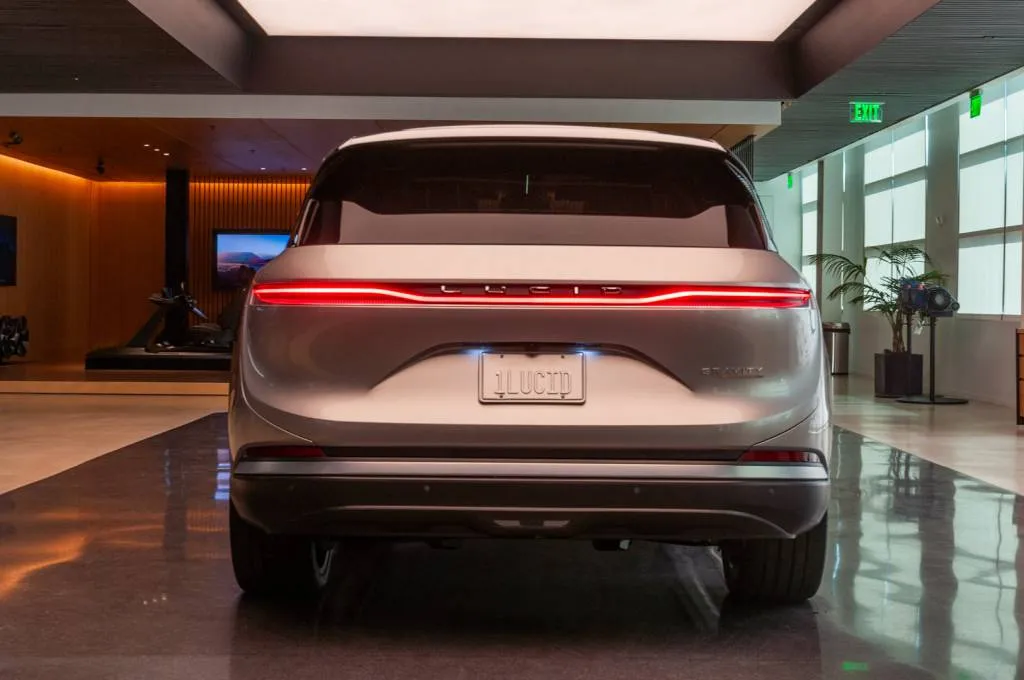
Lucid Gravity
A CCS1 adapter is included with NACS-equipped Gravity models, matching the 400-kw peak of the NACS port sans adapter, Lucid claims. Models equipped with the NACS port will also still be capable of bidirectional charging at up to 19.2 kw, according to Lucid.
Bidirectional charging includes the ability to charge other EVs, dubbed RangeXchange, a feature that debuted on the Lucid Air sedan in 2023. Lucid said it will add Supercharger access for the Air in the second quarter of this year, with more details to follow.
The 2025 Lucid Gravity arrives in Grand Touring form with a $94,900 base price before destination. A $79,900 Touring grade is due to arrive for the 2026 model year. First impressions, in the form of a prototype test drive and a review of a close-to-production Gravity, have been encouraging.

Polestar 6 convertible pushed back to after Polestar 7
The Polestar 6 electric sports car will arrive after the recently confirmed Polestar 7 SUV, meaning it will likely miss the original 2026 launch window.
The news was first reported by Australia’s CarExpert and subsequently confirmed to Green Car Reports by Polestar spokesperson Mike Ofiara.
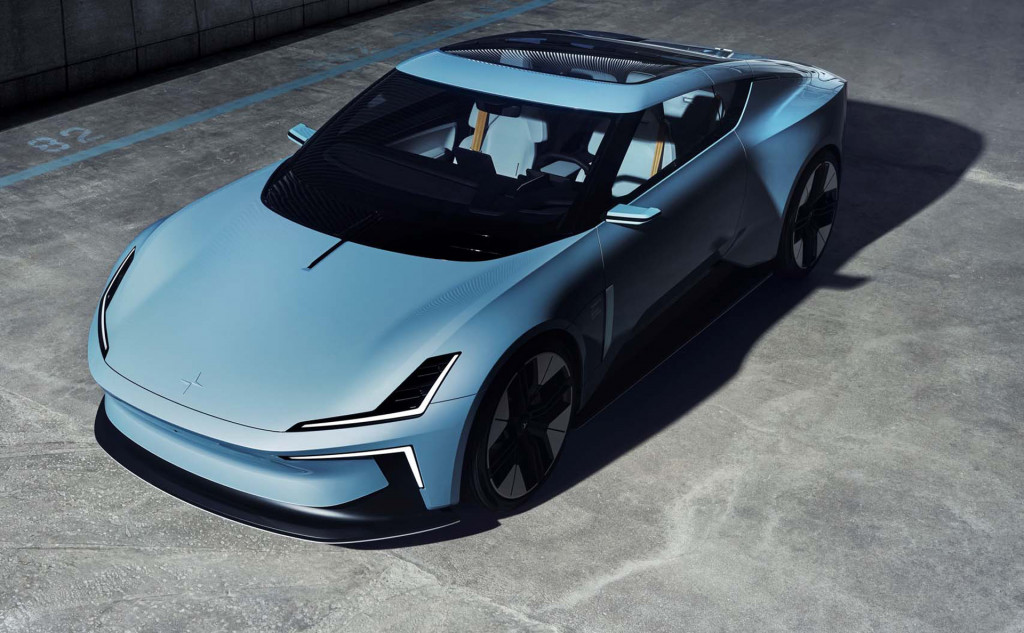
Polestar O2 concept
“The highly anticipated Polestar 6 will arrive at a later stage,” Ofiara said. Polestar’s immediate priority is to follow through on the rollout of the 3 and 4 SUVs, followed by the launch of the Polestar 5 fastback later this year, then the 7 SUV, and finally the 6, he said. Exact timing for the Polestar 7 still hasn’t been confirmed.
Polestar first previewed the 6 in March 2022 with the O2 concept car. It confirmed production plans for 2026 a few months later as well as opening reservations at that time. The 2026 target was still in effect last July when, when Polestar showed the Concept BST at the 2024 Goodwood Festival of Speed, hinting at a spicier version of the convertible sports car.
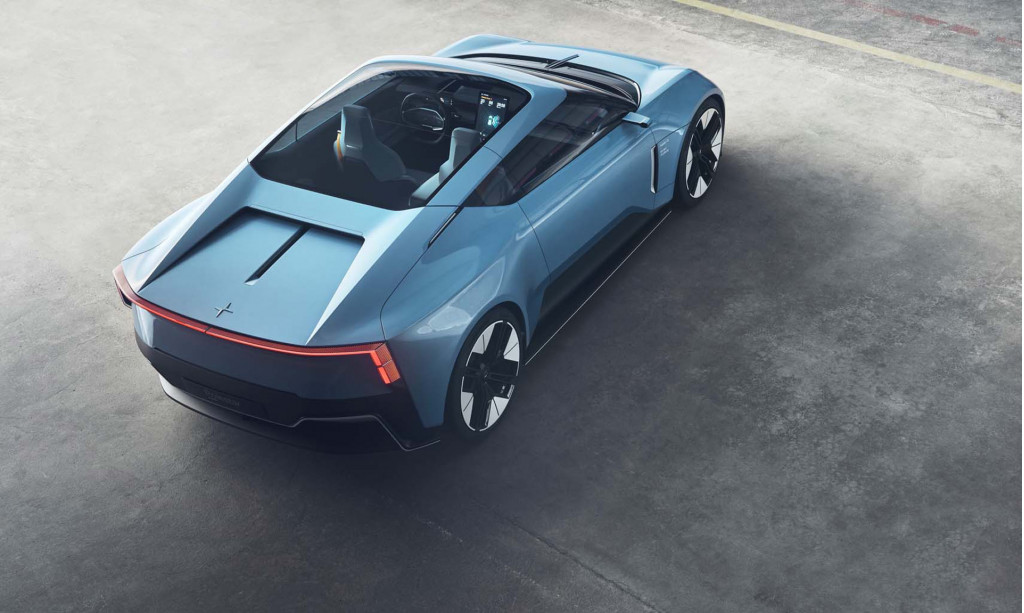
Polestar O2 concept
The Polestar 7 that’s now taking priority is likely to be a higher-volume model than the niche Polestar 6. The compact SUV will be manufactured in Europe, allowing it to avoid steep tariffs currently placed on Polestar’s Chinese-made vehicles. It will introduce a new architecture to be used on all subsequent Polestar models other than the 6, which is expected to use a shortened version of the Polestar 5’s bonded aluminum platform.
While there still aren’t many details, the Polestar 7 has been hinted at as far back as 2022. It was previously rumored to replace the Polestar 2 as the brand’s entry-level model, but more recent reporting indicates Polestar is planning a direct successor to that model later in the decade. The next-generation Polestar 2 will likely use the same architecture as the 7, and could be produced in Europe as well.

Review: 2024 Jeep Wagoneer S electric SUV finally arrives
- Jeep’s first U.S.-market battery-electric vehicle carries a 303-mile range rating and a $71,995 sticker price
- It’s the quickest Jeep in history—better than a Hemi Hellcat
- It’s a Model Y and Lyriq rival for sure—but is it a Jeep?
The 2024 Jeep Wagoneer S is now arriving at dealerships—and it’s about time, if not overdue. The large five-seat electric crossover SUV sits squarely in the premium end of the EV market, and the Launch Edition we tested stickers at $72,000 including the mandatory destination fee. One of two versions is EPA-rated at a combined 303 miles of range; that was the one we drove.
Only about 4,000 model-year 2024 versions were built, all with the high-spec Launch Edition trim. Details on the 2025 Wagoneer S lineup will come “very soon,” execs said, likely at February’s Chicago auto show. They may include both an offroad-focused Trailhawk model and less expensive versions,
Overall, we found the electric Wagoneer to be a competent, pleasant, relatively quick SUV. If we came away with a question, it was over the car’s fundamental identity: What exactly makes this a Jeep?
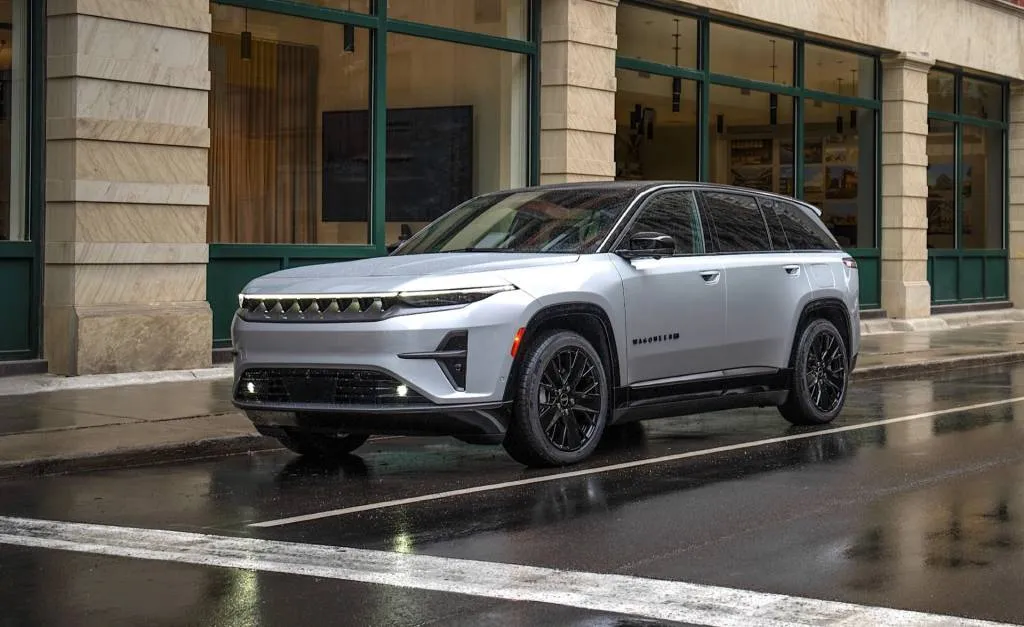
2024 Jeep Wagoneer S
About time, if not overdue
Stellantis, the smallest of Detroit’s resident automakers, has never had a volume electric vehicle to sell. (Two generations of the undeniably “cute” but low-range, subcompact Fiat 500e just don’t cut it.) Now it does.
The electric Wagoneer S is one of two EVs from the former Chrysler that launch within weeks of each other. The second is the polarizing Dodge Charger Daytona, the electric performance car with the audio-enhanced vroom-vroom noises. It’s meant to introduce EV performance to the Hemi crowd—which may well prove to be a tall order.
As a premium electric five-seat SUV, the Wagoneer S should be an easier sell. It sits in a segment that already includes the domestic Cadillac Lyriq and Tesla Model Y, plus imports including the Audi Q6 e-tron, BMW iX, and Mercedes-Benz EQE SUV, with more on the way.
In late January, we drove a Wagoneer S roughly 100 miles in and around the San Diego suburb of Carlsbad, California—with temperate weather and the state’s strong adoption of EVs making it the ideal environment in which to test a new electric vehicle.
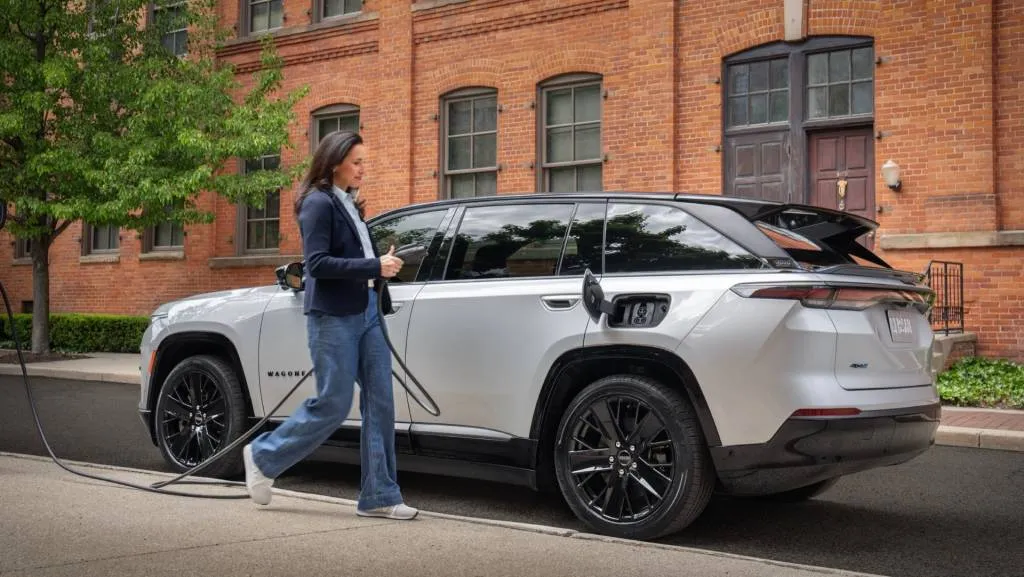
2024 Jeep Wagoneer S
2024 Wagoneer S: An anodyne EV SUV shape
From the front, the traditional Jeep seven-slot grille has morphed into seven fins on a blanking plate with LED accent lights that illuminate the design. It is, designers said, a “confident face” despite the significant bevel from the hood surface down to those fins. The side profile is adequately Jeepish, and it has the characteristic metal lettering spelling out the model name standing proud on the lower front doors.
It’s at the rear where the Jeep identity gets lost. There’s a “4xe” badge, just like all those plug-in hybrids Jeep has sold, and narrow, full-width LED taillights. The very steeply raked rear window is cleverly disguised by a large basket-handle roof spoiler whose vertical side supports give the Wagoneer S a square, SUV side profile. You only see the massive gap between that raked rear glass and the spoiler from certain angles. It’s all about aerodynamics: the quoted drag coefficient of 0.29 makes the Wagoneer S the slipperiest Jeep ever sold.
But we saw nothing at the rear that definitely said Jeep. In fact, coming up to a black SUV ahead at a stoplight, we pegged it as either a Kia or the new Honda Prologue—until we realized it was another Wagoneer S. That’s not great brand ID. The Launch Editions feature a standard glass roof, all-black paint and trim above the beltline, and black alloy 20-inch wheels.
Inside, it’s the same story. The materials, contrast stitching, and multiple displays say “premium SUV,” but it’s not clear to us they really say “Jeep.” Buyers will be the judge of that. One small touch of butch was a starburst pattern on the matte black plastic that now seems to be supplanting the hackneyed shiny piano-black trim in car interiors.
Those displays include a 12.3-inch instrument cluster, a 12.3-inch center touchscreen display, a 10-inch head-up display for the driver, a 10.3-inch touchscreen at the right of the dash for the front passenger, and a final 10.3-inch display for the HVAC controls. The control and infotainment software worked fine, though it seemed slow to load once in a while.
En route, it was nice to be able to re-aim the vents (we’re lookin’ at you, Rivian), though some of the controls (e.g. window switches, lock buttons) seemed oddly small for a Jeep. Parts bin, perhaps? We liked the optional red upholstery, which along with the glass roof brightened the interior considerably.

2024 Jeep Wagoneer S

2024 Jeep Wagoneer S

2024 Jeep Wagoneer S

2024 Jeep Wagoneer S
Quickest, most wind-cheating Jeep ever
Superlatives always excite car marketers, so right up front we learned the Wagoneer S is not just the most aerodynamic but also the quickest Jeep ever, with its pair of 250-kw (335-hp) motors delivering a 0-to-60-mph acceleration time of 3.4 seconds. That’s one-tenth of a second faster than the Jeep Grand Cherokee Trackhawk, with its supercharged 6.2-liter V-8 engine producing 707 horsepower.
The 100.5-kwh (gross capacity) battery uses nickel-manganese-cobalt cells imported by Samsung SDI until a new Stellantis-Samsung joint-venture cell plant in Kokomo, Indiana, comes online early in 2027. The Wagoneer S pack uses 400-volt architecture and doesn’t have the ability to charge at 800 volts as do most Hyundai and Kia EVs. Level 2 charging time from 5-80% is quoted at almost seven hours, and Jeep says the Wagoneer S can fast-charge from 20-80% in 23 minutes (under ideal circumstances, of course).
The headline range rating for the Wagoneer S is 303 miles, and our test vehicle rode on the Falken tires that gave that higher 303-mile rating. We didn’t drive a Wagoneer S on the Pirellis that, as the EPA site shows, busts the rating down more than 10 percent—to 270 miles. The test car, however, started off showing just 258 miles at 95% battery capacity. It likely reflected aggressive driving by Jeep before we got it, as the range algorithm calculates on the last 50 miles of driving. Our drive wasn’t long enough to conclude much on efficiency; we’d guess 2.5 mi/kwh.

2024 Jeep Wagoneer S
Predictably heavy, suitably quick
Behind the wheel and on the road, a curb weight approaching 3 tons (5,667 pounds) was evident, but we found the power generous and fully suitable for short bursts of fast acceleration on, say, uphill on-ramps. The Wagoneer S is predominantly rear-wheel drive, with the “Automatic” driving mode biased 40:60 front to rear. The “Sport” mode ups that to 20:80 to the rear.
We started our drive in “Eco” mode, which is 100% rear-wheel drive unless the front motor is required to maintain traction. Eco required more pedal effort to keep up with traffic, but likely would be suitable for many drivers. The low-speed pedestrian alert noise, by the way, is a pleasantly meditative hum.
Jeep’s regenerative braking wasn’t entirely to our liking: it was almost unnoticeable in the lower setting, but too abrupt in the high setting. For the record, maximum regen produces 0.2 to 0.3g, while the minimum is only 0.04 to 0.08g—a pretty wide range. Perhaps Jeep’s drivetrain-software engineers can drive a selection of EVs from more experienced makers to feel how they round the edges of their algorithms.
While not the most capacious five-seat utility vehicle on the market, the electric Wagoneer S had suitable space for four adults to travel in comfort and five if required. Even the front seats had a slightly knees-up position at its lowest setting, reflecting the thick battery under the floor and a roofline lowered to reduce drag.
It’s worth noting that both our test cars had slight judders during specific low-speed maneuvers. The first one was diagnosed as a malfunctioning front-axle disconnect, and we swapped into a second car halfway through. That one behaved flawlessly until the very end, when reversing produced a minor judder. We didn’t hear the resolution on that one.

2024 Jeep Wagoneer S
Targeting whom, exactly?
Jeep’s new leader, senior vice president Bob Broderdorf, said the brand will target three groups of potential buyers for the Wagoneer S. First are owners of 4xe plug-in hybrid versions of the Wrangler (since 2021) and the Grand Cherokee (since 2022). That’s plausible, except (a) plug-in hybrids are hard to explain to shoppers; and (b) it’s entirely unclear whether many, some, or even any of those owners ever plug in their PHEVs—because Jeep refuses to release data on their plugging-in behavior. Count that group a “maybe.”
The second group is diehards in “the Jeep space,” the true 4×4 crowd who prize Jeeps for their go-anywhere, climb-anything qualities. Think “Trail Rated,” breakover angles, Rubicon Trail, etc. Will the Wagoneer S do off-roading? It didn’t come up in the media briefing—and its 6.4 inches of ground clearance will keep it away from the kinds of rock-climbing the Jeep Grand Cherokee Trailhawk 4xe (at 10.9 inches) can do. Sure, Jeep aired a Wagoneer S ad with the line, “Beautiful things can still get dirty”—but there, “dirty” seems to mean damp and a bit muddy.
To win over Jeep-space buyers, execs strongly hinted they will add a production version of the Wagoneer S Trailhawk Concept it unveiled the same day as the production car. The Trailhawk rides on rugged 31.5-inch all-terrain tires, features a higher ground clearance, and adds a driver-selectable electronic rear-axle locker and a new Rock driving mode.
Finally, Jeep intends to target buyers of domestic EVs in the same segment. Its Wagoneer full-size SUV (the gasoline one) has drawn buyers from Ford and GM competitors, so Jeep feels it can poach some Chevrolet Blazer EV or Cadillac Lyriq or perhaps Tesla Model Y or Rivian R1S owners. Those now driving Audi, BMW, or Mercedes-Benz competitors? We’re not so sure.

2024 Jeep Wagoneer S
Luxury + Jeep … all-electric, or ‘multi-energy’?
Jeep execs hinted the Trailhawk would show up as part of the Wagoneer S range in due course, along with less pricey versions (very likely a single-motor, rear-wheel-drive version with a higher range rating). Presuming a Trailhawk appears, we’ll wait to see what its off-road capabilities are and how the extra gear and ride height affect rated range.
The electric Wagoneer S is built on the STLA Large unibody “multi-energy” platform that also underpins the electric Charger Daytona. We already know the Charger will be offered with a gasoline inline-6 powertrain along with its battery-electric Daytona version.
Jeep execs declined to speak about any future versions of the Wagoneer S—but whether or not the company sells suitable numbers of the electric Wagoneer S, a plug-in hybrid gasoline version appears likely in the lineup within a few years.
Meanwhile, Jeep finally has a respectable, 303-mile battery-electric SUV entry. Now all it has to do is sell it.
Stellantis provided airfare, lodging, and meals to enable Green Car Reports to bring you this first-person drive report.

Genesis concept remakes GV60 EV as off-road rescue vehicle
Cold-weather range loss remains a seasonal form of range anxiety for many electric vehicle shoppers, but a new Genesis concept car aims to prove that EVs can thrive in the cold.
Introduced at the 2025 World Economic Forum in Davos, Switzerland, the Genesis GV60 Mountain Intervention Vehicle concept turns the automaker’s GV60 electric crossover into an off-road rescue vehicle.
To make the GV60 better suited for this role, Genesis swapped the wheels for tracks, adding carbon-fiber fender flares to protect them—and presumably to keep bystanders from being pelted by snow thrown up by them.

Genesis GV60 Mountain Intervention Vehicle concept
Other modifications include sport seats, additional communication equipment, an equipment rack, and modular equipment mounting points on the rear hatch. The GV60’s vehicle-to-load (V2L) capability allows it to serve as a power source for gear stored onboard, Genesis noted.
The GV60 Mountain Intervention Vehicle is a one-off concept, but Genesis is testing ways to improve the efficiency of EVs in cold weather. Just recently the automaker discussed using the 48-volt electrical systems in its current EVs to power heated windshields that could remove frost more quickly than conventional 12-volt solutions—while using less electricity.
EV range loss in cold weather is real, although the extent to which it affects real-world driving habits is less clear. For many EV drivers, it simply means more charging, which can often be done at home. Drivers of internal-combustion cars—which can also see fuel economy dip in colder temperatures—still have to trudge out to gas stations more often in winter.

Genesis GV60 Mountain Intervention Vehicle concept
The GV60 arrived in the U.S. as a 2023 model and gets a handful of updates for 2026, including a 27-inch dashboard display and tiny styling tweaks. Genesis hasn’t confirmed U.S. specs yet, but the GV60 could also get a larger battery pack like the Hyundai Ioniq 5 and Kia EV6, with which it shares the Hyundai E-GMP platform.
A GV60 Magma performance variant is also expected to arrive as a 2026 model, ushering in the new Genesis Magma performance sub-brand announced at last year’s New York auto show.

2025 Chevy Equinox EV recalled for cruise-control braking issue
General Motors is recalling all-wheel drive versions of the 2025 Chevrolet Equinox EV because of adaptive cruise control systems that may fail to engage the brakes when needed.
The recall of 2,890 electric vehicles comes in response to a software issue, according to the NHTSA. An “incorrect software calibration” of the brake control module prevents adaptive cruise control from applying the brakes. The system may still try to slow the vehicle by cutting power, but that may not be sufficient to avoid a crash.
Drivers can still apply the brakes manually, but they may not receive enough warning to slow the vehicle in time to avoid a collision, the NHTSA noted. Drivers of affected vehicles should thus be extra vigilant when using adaptive cruise control, and be ready to hit the brake pedal.
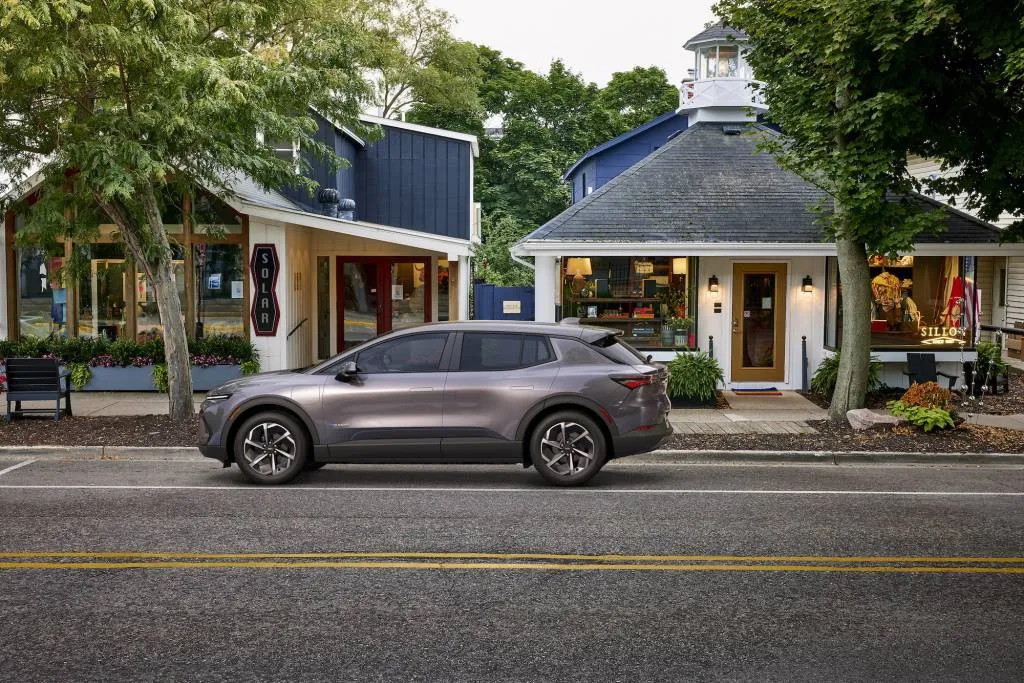
2025 Chevrolet Equinox EV
The recall covers 2025 models with all-wheel drive that do not have the more advanced Super Cruise system, which steps up automation enough to allow hands-free driving on sufficiently-mapped stretches of road. GM told the NHTSA that it is not aware of any crashes or injuries related to the software issue in affected vehicles.
Dealers will install updated brake control module software to fix the problem, free of charge. GM noted that some unsold vehicles will also receive the software update over-the-air, adding that all affected vehicles remain under warranty, so no customer reimbursement should be necessary.
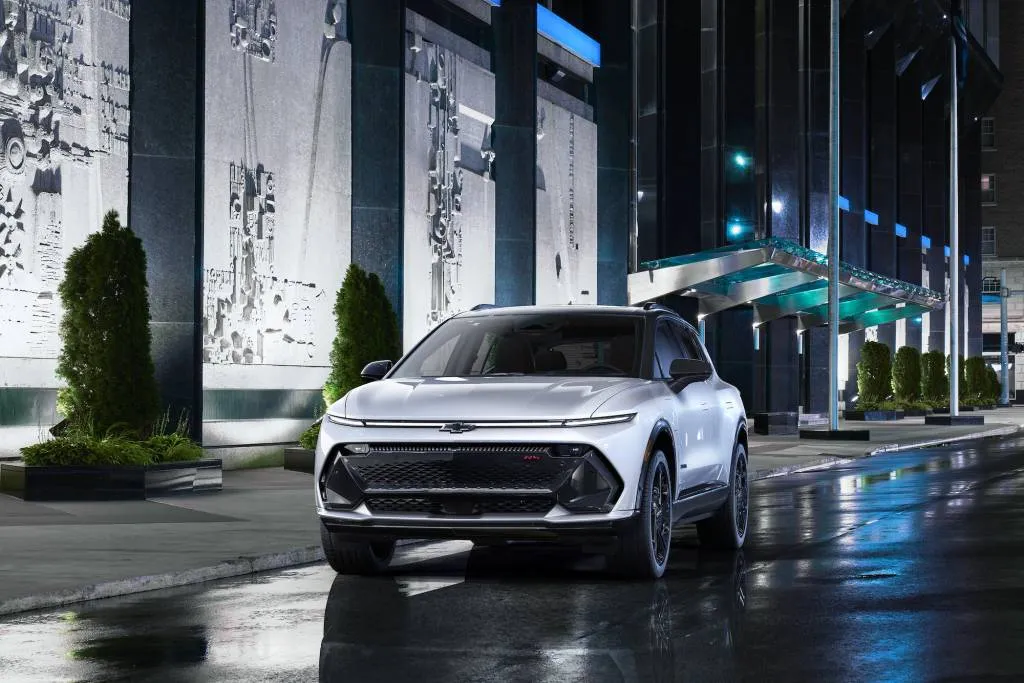
2025 Chevrolet Equinox EV
GM expects to notify owners via the mail starting Mar. 3. In the meantime, owners can also call Chevy’s customer service department at 800-222-1020, and mention recall number N242481530 for more information.
This is the second recent recall for the 2025 Equinox EV. In December 2024, GM recalled 7,606 of the electric crossovers because their federally mandated pedestrian warning systems might be too quiet. The Equinox EV launched as a 2024 model, but the 2025 model year brought additional configurations, including a $34,995 version with 319 miles of EPA range that finally fulfilled the crossover’s value promise.

Audi Q6 E-Tron off-road concept debuts with portal axles
The Audi Q6 E-Tron electric crossover wasn’t designed for hardcore off-road use, but a new concept car explores the possibilities of a more rugged EV from the German automaker.
Audi posted photos of the concept—dubbed the Q6 E-Tron Off-Road—on social media Thursday, but didn’t provide much detail on its features. But it appears to use portal axles to raise ground clearance and allow for the biggest-possible tires.
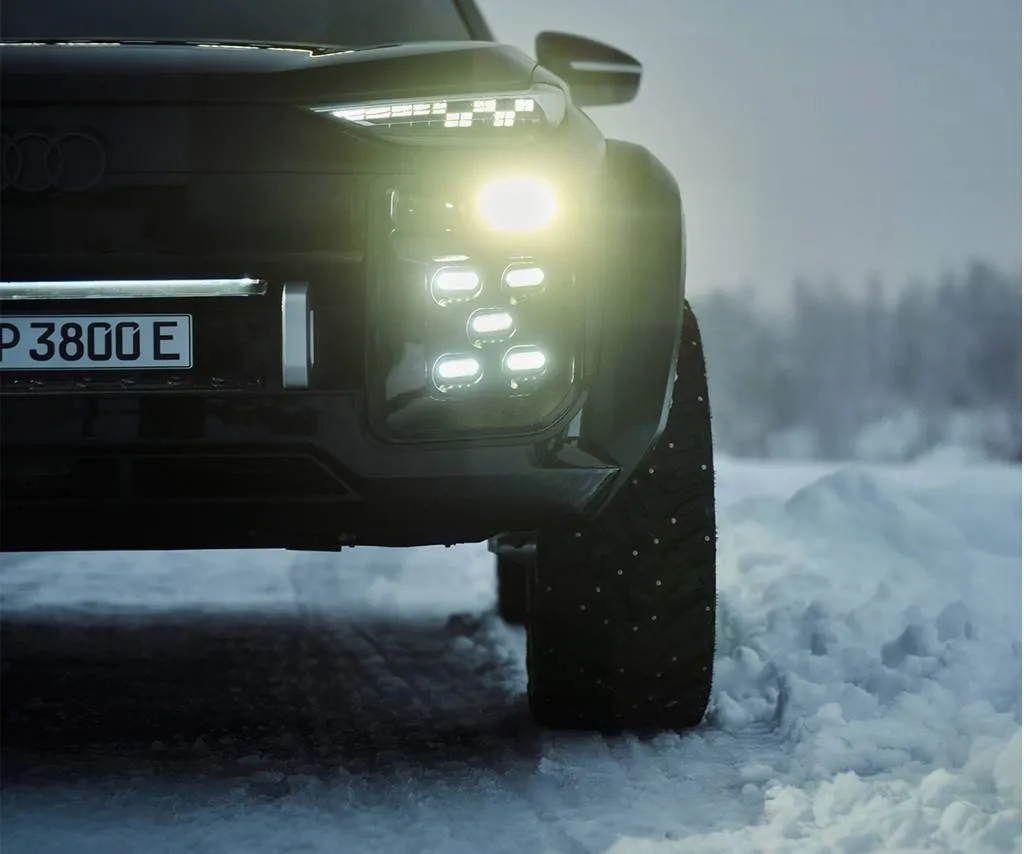
Audi Q6 E-Tron Off-Road concept
Unlike conventional axles, portal axles situate the wheel hub below the axle hub, separated by gears. In addition to increasing ground clearance, portal axles allow for a wider stance, and the additional set of gears allows for lower gearing beyond the differential.
Mercedes-Benz previously used portal axles for a concept version of its EQC electric crossover, which was originally slated for U.S. sales but never made it here. That concept scouted the trail for Mercedes’ electric G-Class, but it’s unclear if Audi has a similar off-road production model in mind.
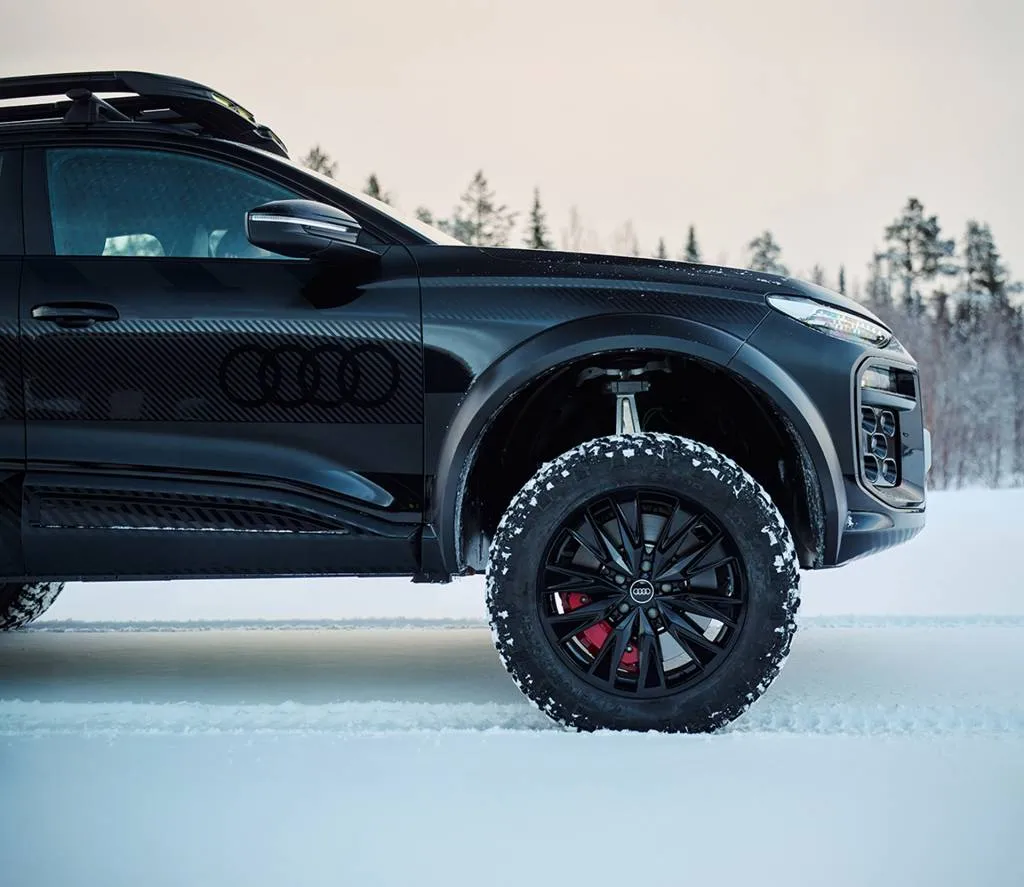
Audi Q6 E-Tron Off-Road concept
Audi teased a more rugged EV in 2023 with the Activesphere concept, which was based on the same Premium Platform Electric (PPE) as the Q6 E-Tron. PPE, which brings high-power charging hardware pioneered in the Audi E-Tron GT to more EVs, is also shared with the A6 E-Tron sedan and the electric version of the Porsche Macan.
The Q6 E-Tron Off-Road is based on the sleeker Sportback body style of the Q6 E-Tron, which hasn’t reached the U.S. yet. Only the standard SUV body style is currently available to order in the U.S., as a 2025 model, with a $65,095 base price including a $1,295 destination charge. It offers up to 321 miles of EPA, and a first drive in California indicated achieving something close to that in the real world isn’t a stretch.

Rivian exec says automakers knocking on door
A joint venture between Rivian and the Volkswagen Group is attracting interest from other automakers as Rivian looks to roll out more advanced driver-assist systems.
Announced last June and formally created in November, the joint venture calls for Volkswagen to take a $5.8 billion stake in Rivian in exchange for access to the U.S. automaker’s electrical architecture and software development expertise. Now other automakers are reportedly looking to join in.
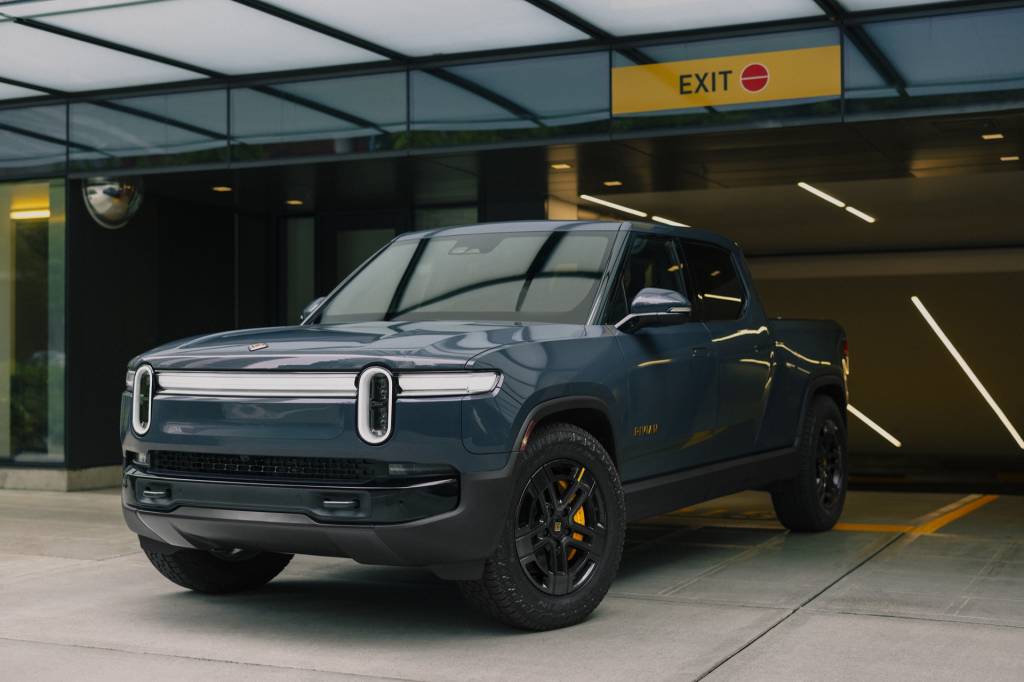
2025 Rivian R1T
“I’d say that many other OEMs are knocking on our door,” Wassym Bensaid, who serves as both Rivian’s chief software officer and CEO of the joint venture, said in an interview with Reuters published Thursday. Bensaid declined to provide the names of the interested automakers.
Rivian’s electrical architecture, as used in the current R1S SUV and R1T pickup truck, requires fewer electronic control units and wiring, making it attractive to other automakers looking to cut weight, cost, and complexity from their vehicles, Reuters reported. But for now, Rivian’s priority is to get the more affordable R2 electric SUV into production and then integrate its tech with VW Group vehicles, Bensaid emphasized.
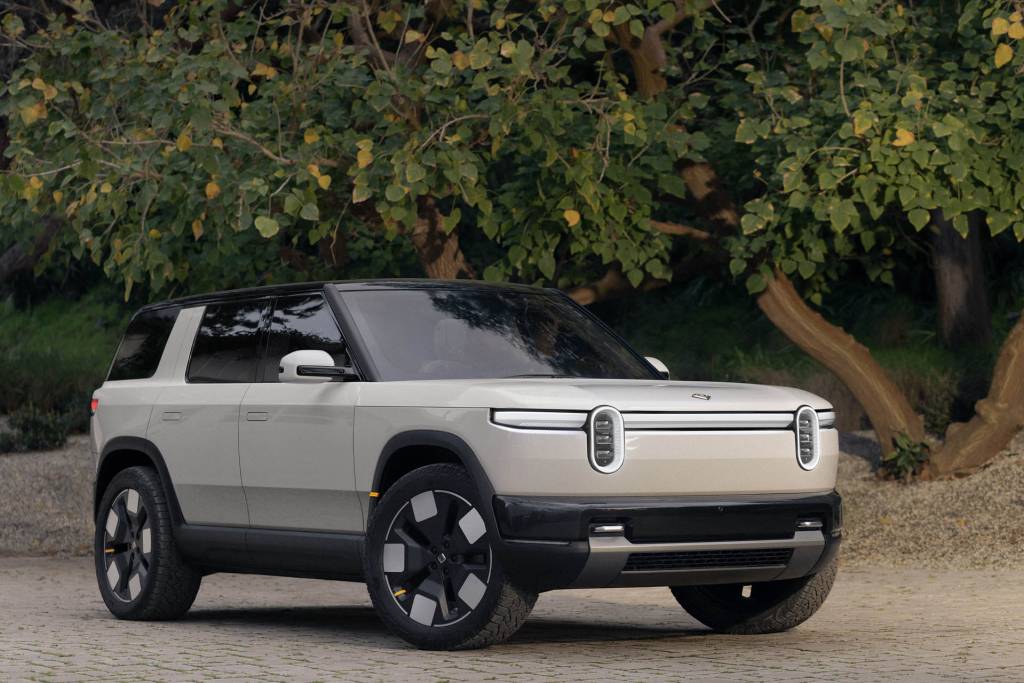
Rivian R2
“Obviously other OEMs are talking to us and we’re trying to figure out how to support that in the future,” Bensaid told Reuters. “Any other OEM who wants to make a leap from a technology standpoint, the joint venture today becomes one of the key partners with whom they can make that collaboration.”
In a separate Reuters interview also published Thursday, Rivian CEO RJ Scaringe said the automaker also aims to launch a hands-free driver assist system in 2025 and an “eyes-off” system in 2026. Hands-free systems like Ford’s Blue Cruise and General Motors’ Super Cruise are already available, while Mercedes-Benz is the only automaker to offer a true eyes-off system in the U.S., albeit on a limited basis.

BMW’s upcoming EVs set the design for future gasoline models
- Gas or electric, future BMWs will have the same look
- Upcoming Neue Klasse EVs set stage for design of gas models too
- BMW sold more EVs in 2024 than Audi and Mercedes-Benz combined
During a media roundtable at CES 2025 in Las Vegas earlier this month, BMW’s chief development officer Frank Weber, who’s been tasked with leading development of BMW’s forthcoming product portfolio, declared: “A BMW is a BMW and for us this is so fundamental.”
The executive was referring not just to the automaker’s Neue Klasse EVs, which will launch later this year, but to what will follow with gas tanks and tailpipes. What powers a vehicle shouldn’t define the design, according to Weber.
“We can only have one design,” Weber said, followed by “there is no difference between an ICE car and a battery electric car.”
The issue with two designs stems from making one feel newer and the other older or outdated, Weber explained. BMW won’t try and sell an electric car as “more modern” than its other vehicles either, he said.
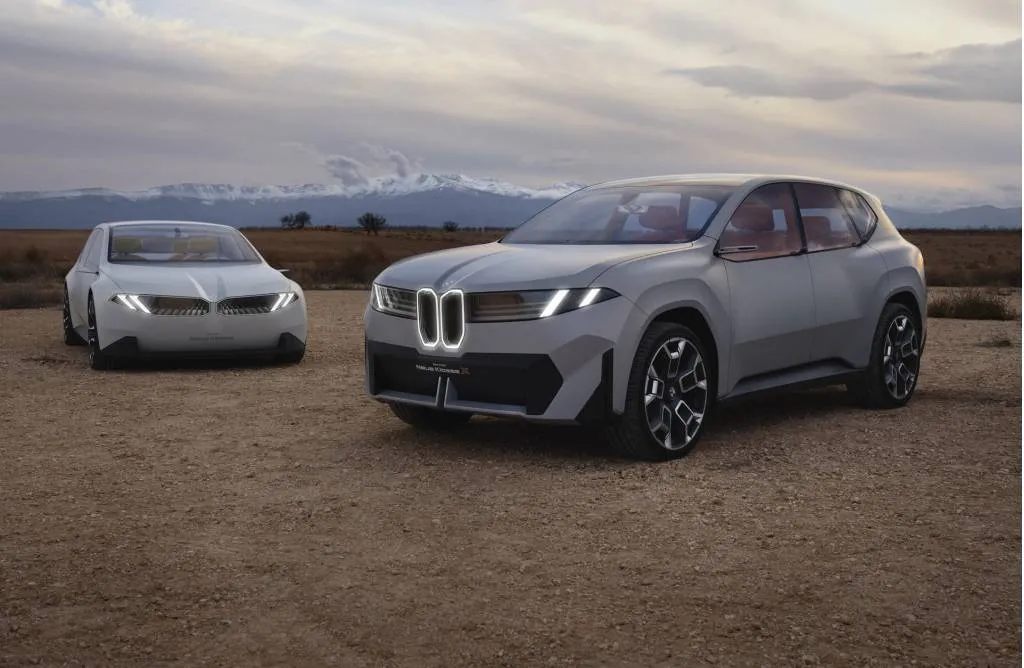
BMW Vision Neue Klasse X concept
Unlike other automakers, BMW is in the process of embracing the same essential design language among both internal combustion engine vehicles (ICE) and battery-electric vehicles (BEV). Smaller differences such as grille shapes or rear diffusers can be different, but the language and essence are the same as seen with the current 5- and 7-Series lineups. The i4, i5, and i7 all look like they fit alongside their gas-powered siblings.
The executive noted that splitting EV design completely from gas-powered cars is “probably one of the biggest mistakes some of the competitors were doing.” BMW’s upcoming Neue Klasse EVs, on the other hand, will share their design with gasoline-fueled models, Weber confirmed.
If this is a big mistake by Weber’s description, BMW made it too. The automaker’s early EV, the i3, featured futuristic design that stood out from the rest of the lineup. The same could be said for its wild i8 plug-in hybrid sports car that came alongside the i3. The iX crossover SUV has stood differently in design from other models for several years, though it might bridge the gap between today’s gas-powered lineup and tomorrow’s Neue Klasse EVs.

2024 BMW i4 M50
Audi reported that in 2024 it sold over 164,000 EVs, while Mercedes-Benz said it sold 185,100 EVs, and BMW said it sold 426,594. Weber attributed BMW’s EV sales dominance over fellow German luxury brands Mercedes-Benz and Audi in 2024 due to its strategy of all cars getting equal design treatment.
Mercedes and its lineup of EQE and EQS EVs shifted to a cab-forward design language that’s markedly different from both its E-Class and S-Class sedans and its GLE and GLS crossover SUVs. Notably, the new electric G-Class looks like its gas-powered sibling aside from its different wheels and grille.
Audi’s lineup of EVs, which includes two crossovers SUVs and a four-door sports sedan that’s a reskinned Porsche, doesn’t stand out like the Mercedes EVs. Those models blend into the automaker’s lineup in terms of design.
What Weber confirmed won’t change in this methodical shift to EVs is BMW’s hierarchical lineup of number-based model series, which spans from a 1-Series (X1, for the U.S.) all the way to a 7-Series. “This is so precious that you have a certain hierarchy that people know what to get,” he said.
According to Weber, dealers report people aren’t walking in knowing which exact powertrain they want. Customers are really thinking about it and asking themselves, “Am I ready?” And if the answer is no then the automaker’s able to accommodate that.
“The more relaxed we are and the more they feel respected in the strategy of the company, the easier it is to sell vehicles,” Weber noted.
BMW paid for travel and lodging so we could bring you this firsthand report

Mississippi-made Nissan EVs set for 2028, as product plans shift
- Nissan reassesses plans to build a fifth EV model in the U.S., but four remain set
- Shift of Mississippi plant to EVs has in recent months been pushed out to 2028
- Plans to build a small electric crossover there have reportedly been canceled
Nissan has abandoned plans to produce a particular small crossover electric vehicle in the U.S., Automotive News reported Wednesday.
According to the report, Nissan made plans to build the EV—codenamed PZ1L—at its Canton, Mississippi, plant for U.S. sale. But amid evolving product plans, it’s reportedly now consolidating production of that vehicle to its Sunderland, U.K., plant. That likely means the PZ1L won’t be sold in the U.S., according to the report.
But beyond the four EVs already planned for Canton, there may still be room for more, according to Nissan.
“At the current time, we are focusing our planning efforts on the other four EV projects for the Canton plant, which will better meet the needs of the market and deliver higher volumes,” Nissan vice president of communication Brian Brockman said to Green Car Reports. “As is always the case in the planning process, we will continue to evaluate market opportunities for new models and make adjustments accordingly.”
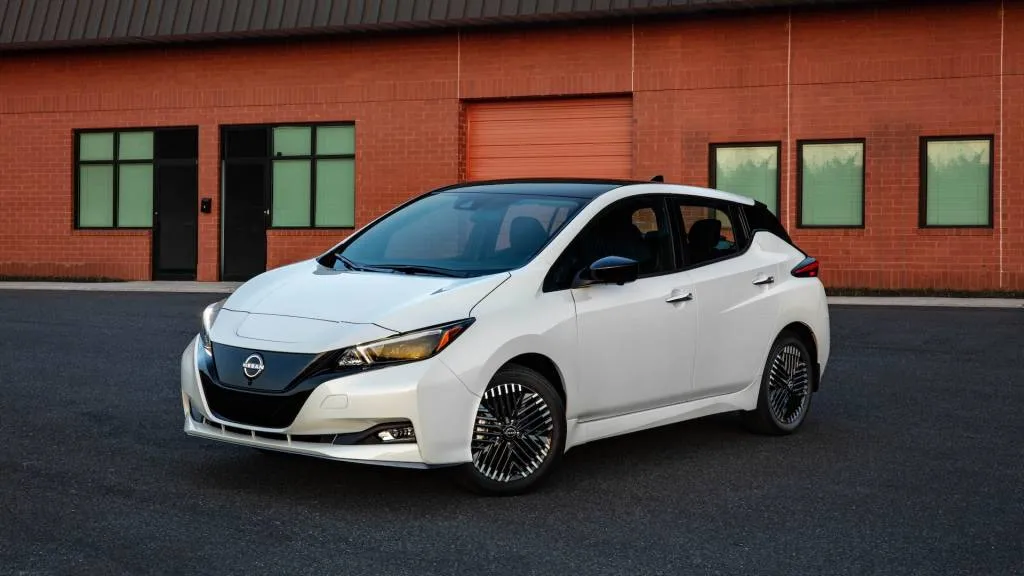
2025 Nissan Leaf
The automaker’s plans to build Nissan and Infiniti EVs in Canton had recently been delayed to 2028, from a 2027 start noted last year. It had originally announced plans for a 2025 start—back in 2022 when it announced the project.
According to recent comments from the automaker, Nissan is indeed planning for five vehicles from the plant.
“Nissan remains committed to the future of mobility and electric vehicle production,” said manufacturing and labor spokesperson Amanda Plecas last week to the Madison Country Journal. “Our Canton, Mississippi facility will transform into a Nissan Intelligent Factory, supporting the manufacture of five next-generation electric vehicles beginning in 2028.”
The Journal noted that the Nissan official would not confirm rumors over whether the Canton plant’s workforce might be downsized as the plant transforms into a Nissan Intelligent Factory that embraces more robotics and a zero-emission production system.
It’s unclear if the PZ1L is one of the three electric crossovers Nissan confirmed for its Sunderland plant in 2023. Two of them included electric versions of the Juke and Qashqai, with the latter unlikely to reach the U.S. The third is expected to be a crossover-influenced sequel to the Leaf, which is expected to arrive for the 2027 model year and has been tipped as U.S.-bound by Nissan officials.
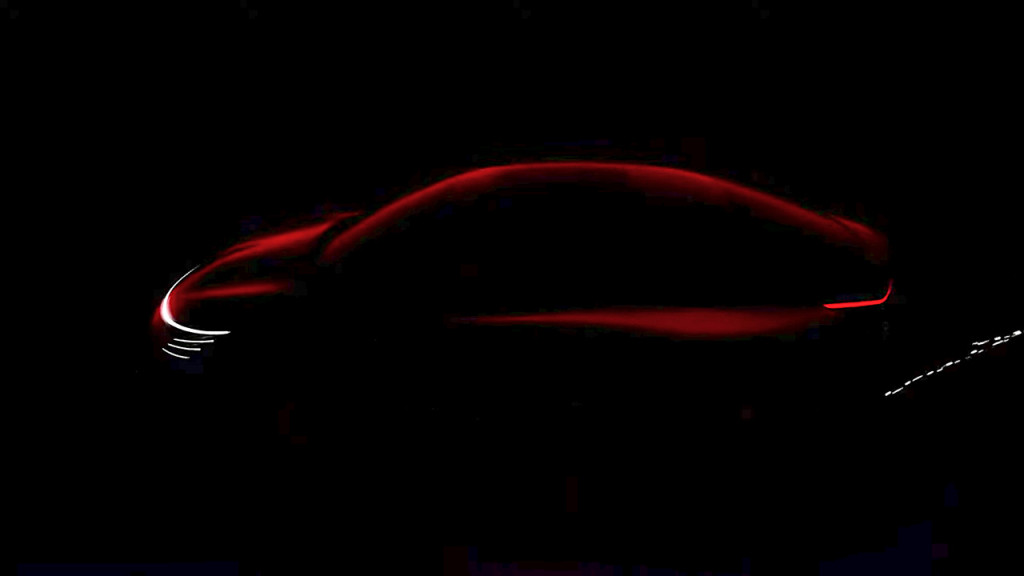
Nissan EV to be made in Mississippi
The Mississippi plant currently assembles the gasoline Altima sedan and Frontier pickup truck. Although Nissan has communicated the plant timing changes as a delay, Automotive News noted that last summer’s delay was different, with the automaker telling suppliers that it was pausing plans for EV production in Canton and putting a $500 million investment in the plant on hold.
A few months later, Nissan announced that it would lay off approximately 9,000 employees globally, representing 6.7% of its global workforce, and cut production capacity by 20% due to declining sales, primarily in the U.S. and China. The situation has led Nissan to pursue a merger with Honda, which the two automakers hope to complete by 2026.
—Senior editor Robert Duffer and senior editor Bengt Halvorson contributed to this report.

Lucid dumped Alexa, aims for EV context with new voice assistant
- Lucid’s new voice assistant incorporates natural-language interactivity
- SoundHound tech doesn’t rely entirely on a cellular connection
- Already available in Air, coming soon to Gravity
Lucid wants you to have a conversation with your Air or Gravity electric vehicle, and it goes far beyond the requisite wake-up of “Hey Lucid.”
Earlier this month I sat in the passenger seat of an Air, while the driver asked: “My friend suggested that I go check out the NFL stadium while I’m in Vegas; what’s it called?”
A synthetic voice replied within a fraction of a second: “The NFL Stadium in Vegas is called the Allegiant stadium. It’s super cool.”
“Navigate there,” said my seatmate.
The voice eventually confirmed, “Navigating to Allegiant stadium. Follow the road.”
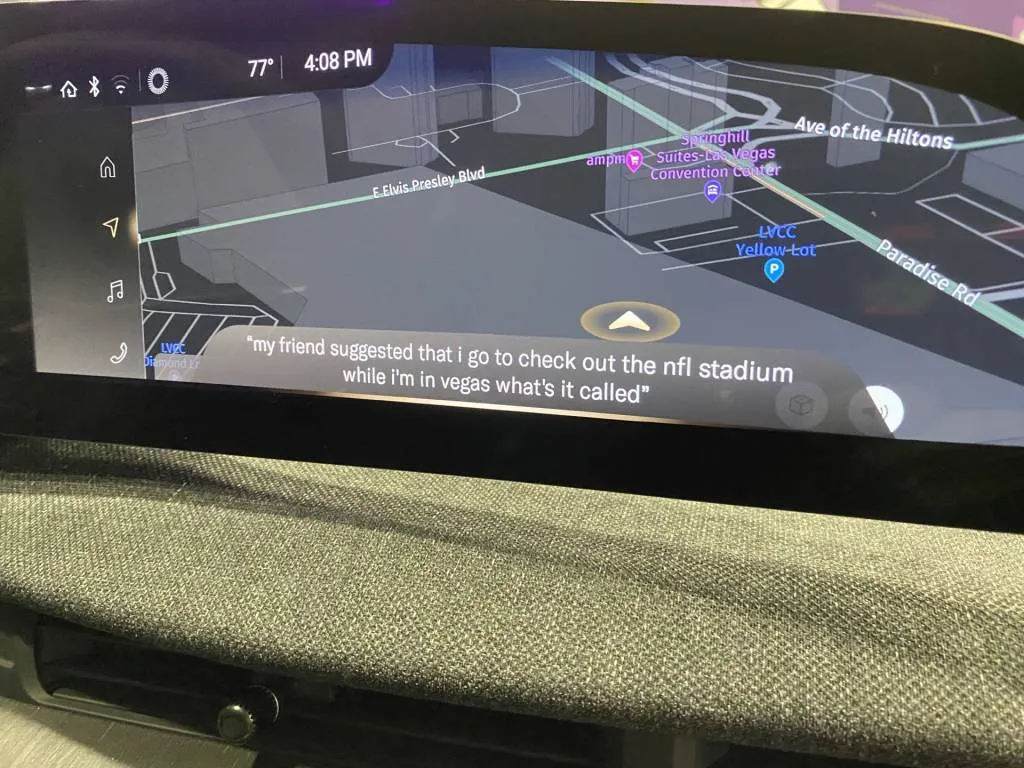
Lucid Assistant powered by SoundHound (demo)
The one in the driver’s seat walking me through Lucid Assistant voice interactivity was Kyle Halstvedt, the technical program manager at SoundHound who helped coordinate this completely new voice assistant for Lucid EVs.
With SoundHound’s voice-and-AI-focused team based in Santa Clara, California, near Lucid’s Newark headquarters, the companies worked closely on the project. Halstvedt aimed to show me that every voice query now has a lot of flexibility, and the voice functionality is now fully in tune with Lucid’s needs—like the need to find the fastest chargers along the way, plan the EV’s route, and precondition its battery to prepare for them.
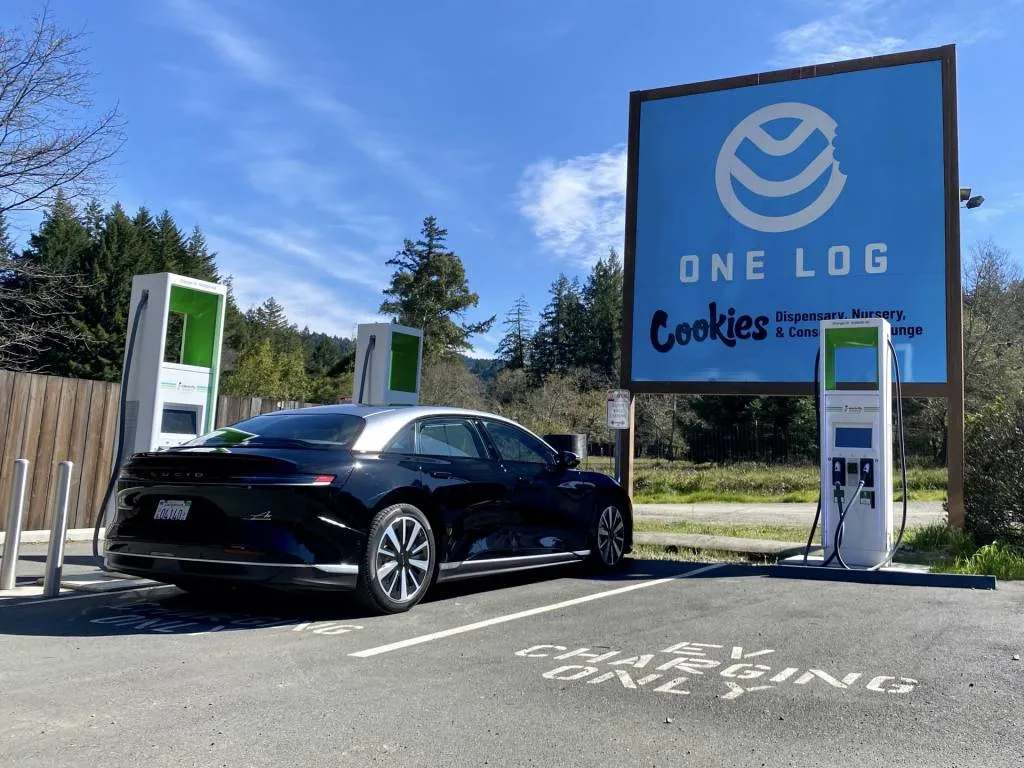
2022 Lucid Air fast-charging in Garberville, CA
Here it’s especially important that this functionality navigates the nuance—because in a Lucid it can be the difference between one of the quickest EV charging experiences in the world versus one that’s just par.
“That was a fun aspect of this project, that they want to drive things through their own navigation system,” Halstvedt said. “We’re not just using a separate data provider; we’re deeply integrated with their navigation system, and that had to happen.”
Halstvedt noted that’s something SoundHound has experience doing before, and it’s something that Lucid had a particular requirement surrounding the project and the integration. “They appreciated the flexibility of our technical team to build the experience they’re looking for, something that takes a bit of creativity on the technical side,” he said.
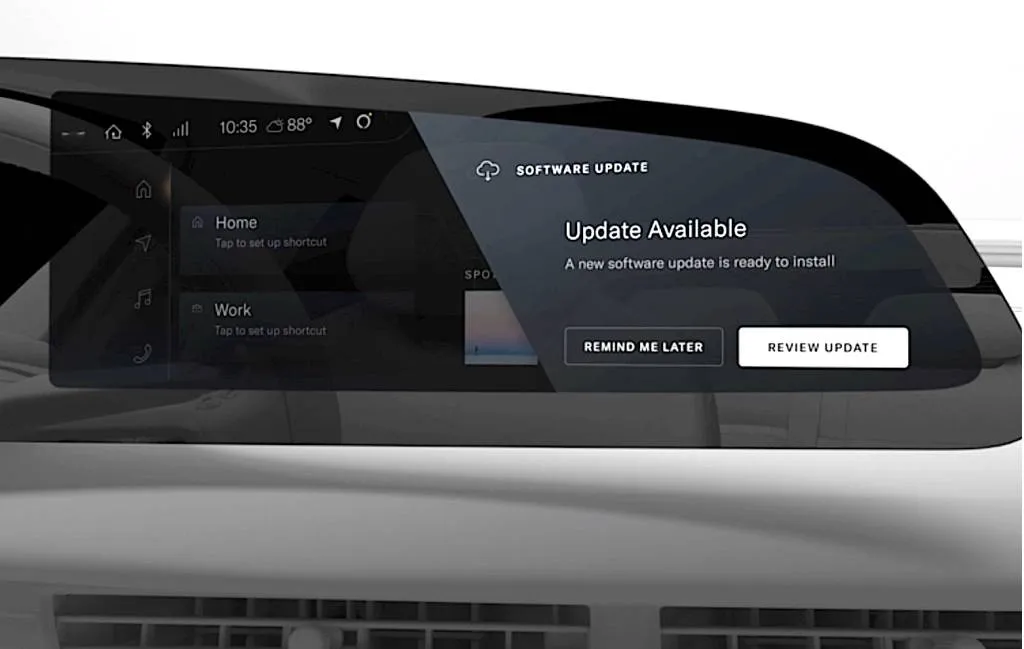
Lucid UX 2.4 update
Way more flexibility, better than Alexa
The Lucid Assistant was rolled out starting in September, replacing Alexa as part of Lucid’s UX 2.4 software update. According to Lucid, all Air models in North America and the Middle East now have access to it. Early Gravity models don’t yet have the Lucid Assistant, but they will soon, the automaker told Green Car Reports.
The new assistant, already configurable in six languages, will now better manage navigation and audio, climate control features, or heated seats—all basics that owners previously found challenging. But that’s just the start.
Lucid made a strategic choice about where it wanted its core competency, and voice is at the center of it, Lucid Motors head of user experience Dave Flint explained to Green Car Reports in December, when that system was still rolling out in Air. “It’s not just, I’m ordering the car around; it’s like, how does the car begin to communicate with me through voice?”
“That really wasn’t possible with our old system,” Flint bluntly summed.
Alexa wasn’t working for Lucid, and Lucid didn’t mince words about it—although there were likely plenty of drivers’ words minced. The California EV maker announced back in 2020 that it would employ an advanced version of Amazon Alexa to access an extensive array of vehicle functions ranging from small adjustments to finding charging stations, as well as tap into smart home controls. But what owners were finding out in the real world was that such commands within the vehicle depended too much on a strong data connection; account permissions and other factors could get in the way; and ultimately Lucid didn’t have a lot of control over how smoothly it all worked in the real world.
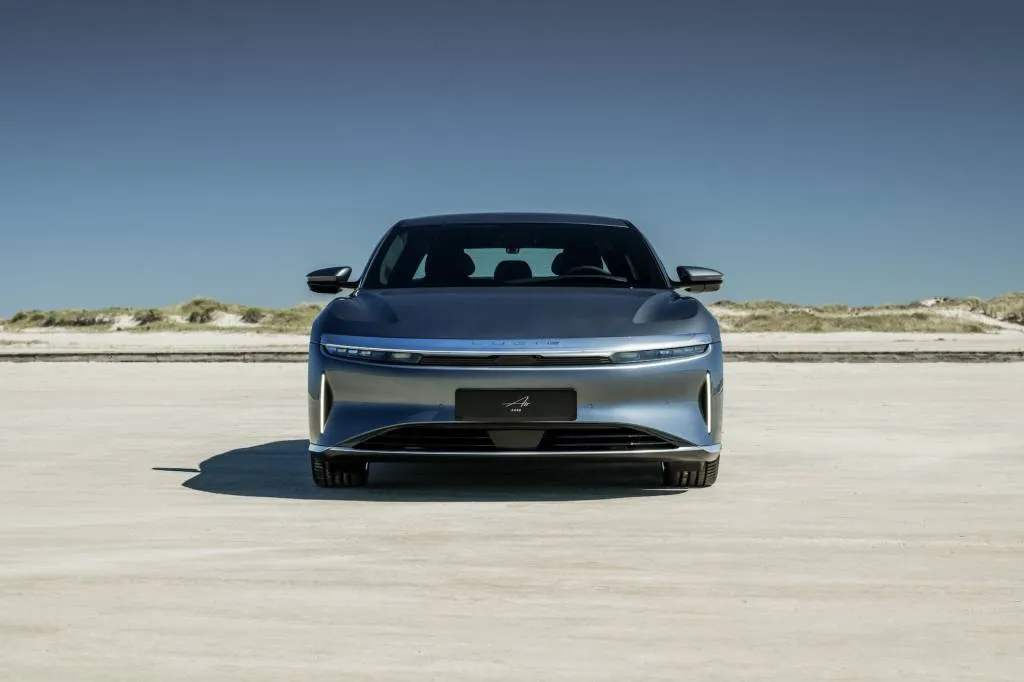
2025 Lucid Air Pure
Context is everything to new Lucid Assistant
“What we need to do a good job, at the natural language commands, is surrounding context—whether that’s the history of the conversation, knowledge about the natural world, or the position, where the user is,” Halstvedt said.
Consumers expect to be able to have an extended conversation about a location or series of locations, filtering it iteratively, and then they want to be able to act on it based on the cumulative results, he said. But few new vehicles can actually deliver that even in perfect connectivity.
SoundHound hasn’t ignored the uncanny smoothness of AI-based queries and chatbots, but it understands that way more is needed within the vehicle—and it needs to pair some of those advantages with traditional in-vehicle voice processing.
“If you just plugged OpenAI’s APIs into your vehicle it would do a really good job of talking but it wouldn’t do a really good job of acting,” Halstvedt said. “We want to bring together those strengths.”
To do that, the voice assistant runs on the reality that it won’t always have a cellular connection out on the road. In what SoundHound calls a native-hybrid model, it streams audio to servers or to a local embedded engine, balancing that in whatever way makes sense.
“Alongside the voice we’re sending, we’re also sending a set of data which we call request info, that represents all of the different attributes, like location, time zone, and more,” Halstvedt said. “That’s a key aspect of answering these questions.”
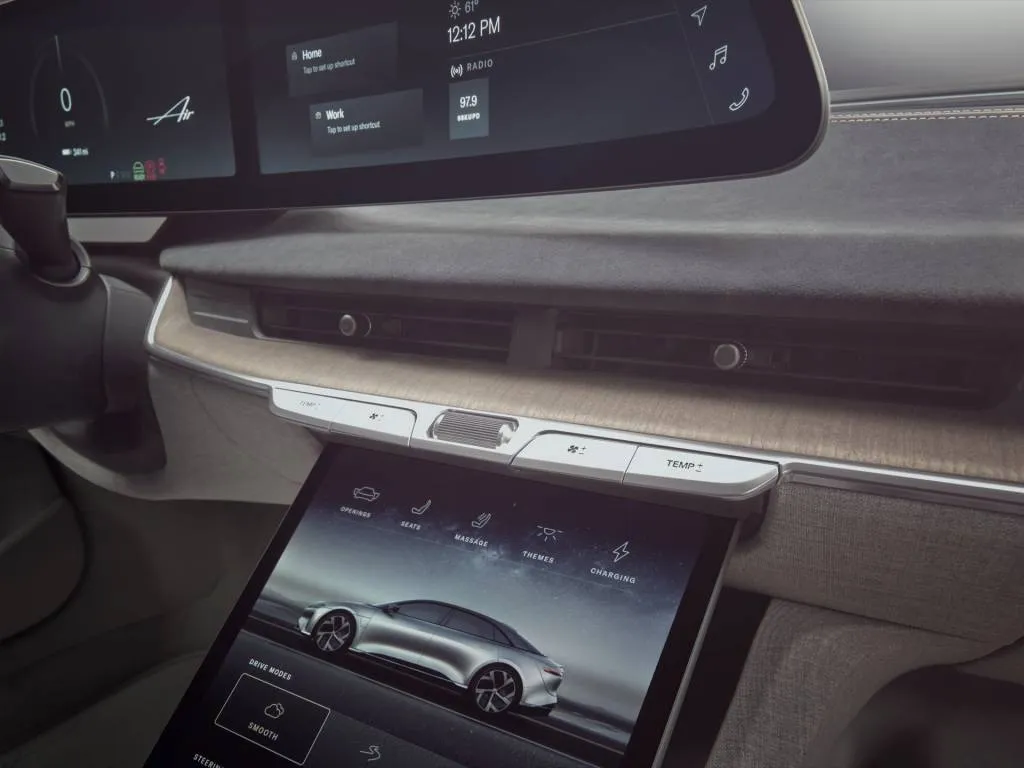
2025 Lucid Air Grand Touring
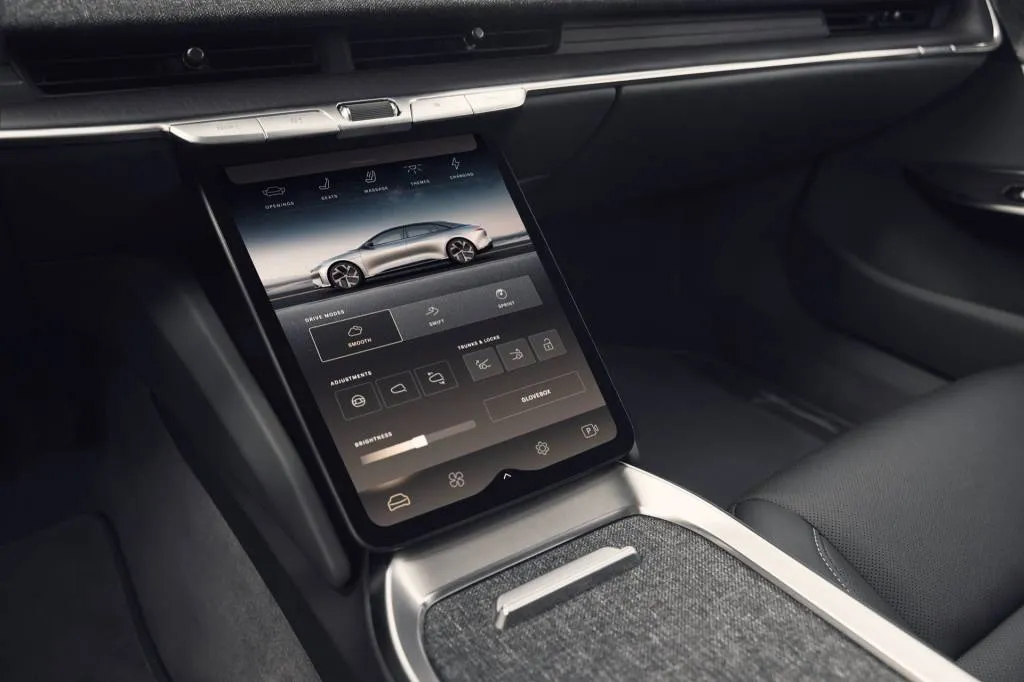
2025 Lucid Air Pure
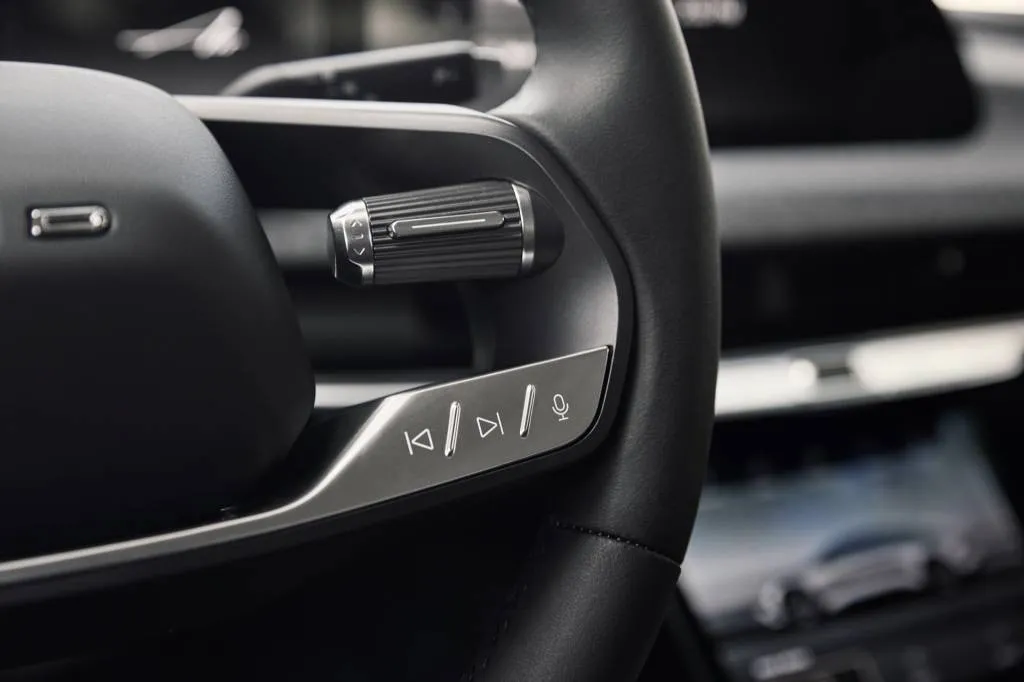
2025 Lucid Air Pure
Fewer “AI hallucinations,” connectivity optional
The approach also lowers the chances of so-called “AI hallucinations,” according to SoundHound—startling or tangential responses that seemingly have nothing to do with what was asked.
While it can seamlessly support those complicated natural conversation queries, it can, as Halstvedt put it, “Work decently well without a connection,” and provide some degree of the same experience.
As an example of something that needs to capture the nuance but doesn’t require a connection, he said, “It’s a little hot in here.”
“Decreasing temperature by two degrees Fahrenheit,” the voice replied.
“If we have cloud connectivity we can enhance those results with better results from the cloud and really mix in various voice generative AI features without having to be really costly from a computing standpoint,” Halstvedt added.
But in Lucid’s new approach, it’s also drawing from around 20 years of SoundHound’s work in understanding natural-language commands without access to the large-language model built into generative AI.
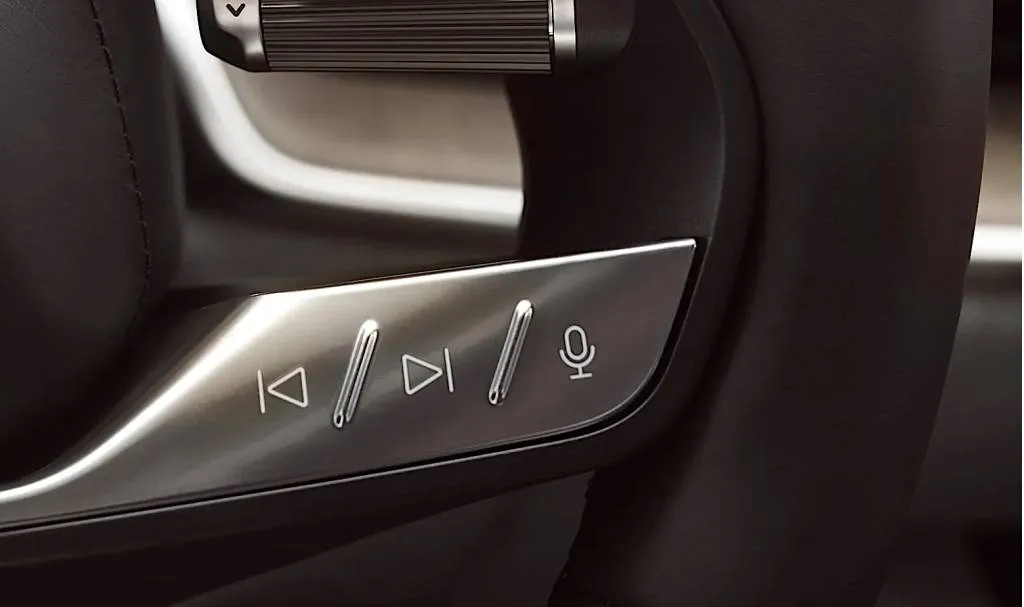
Lucid Air Touring steering wheel controls
Lucid’s voice assistant knows the owner’s manual
Versus the previous voice commands, SoundHound brings in new features, including what it calls vehicle intelligence—meaning “relevant and official information about all of the features the vehicle supports, like where things are and what the buttons do,” it explained in a recent press release on the feature set.
SoundHound has worked with other automakers, but it points to Lucid’s vehicle intelligence questions as where this integration covers new ground in natural language and AI. The whole owner’s manual is available via voice, and the system can sift through it based on your questions—even when you can only describe icons, symbols, or warning lights.
“We applied some computer vision techniques to allow symbols to be described from the vehicle manual… to make knowledge about the car a lot more accessible at the times a user might need to access it,” Halstvedt said.
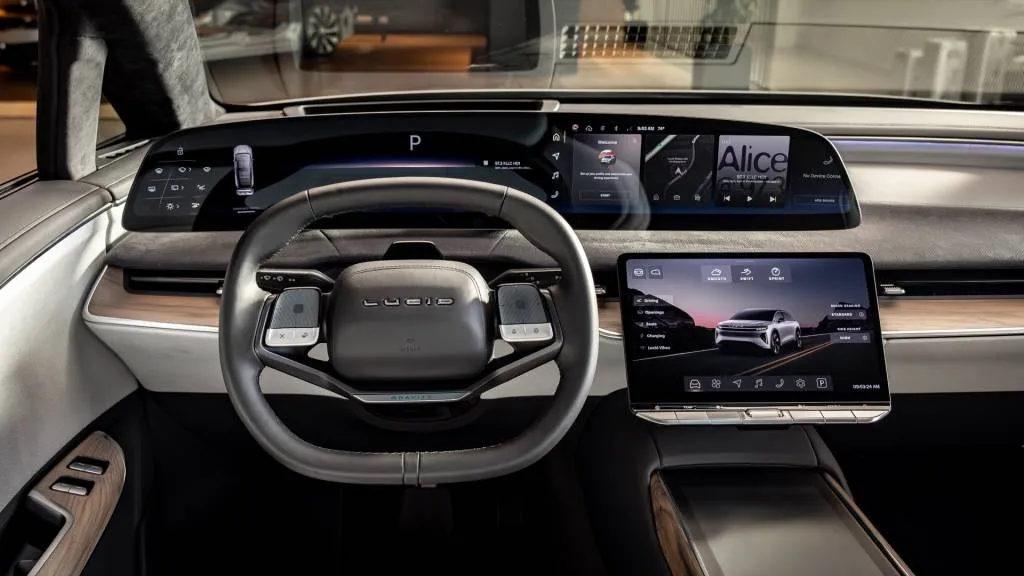
2025 Lucid Gravity Grand Touring
Voice controls in the 2025 Lucid Gravity
The hybrid model has also made the voice system easy for Lucid to adapt and customize as the Air and Gravity evolve and differ among trim levels. The teams overseeing functionality can change the way something works via the cloud almost instantly, with the local/native backup changed soon after via an update.
“We’re investing heavily in voice; it’s going to be a strategically important UX for us, with a lot of implications around what it means for natural-language interaction and natural-language engagement from the car,” Flint said.
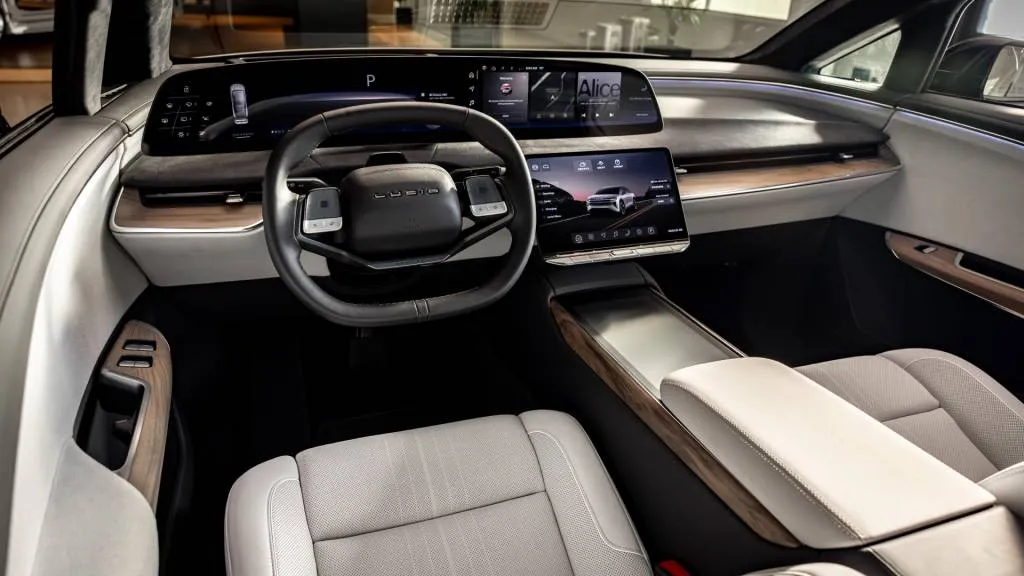
2025 Lucid Gravity Grand Touring
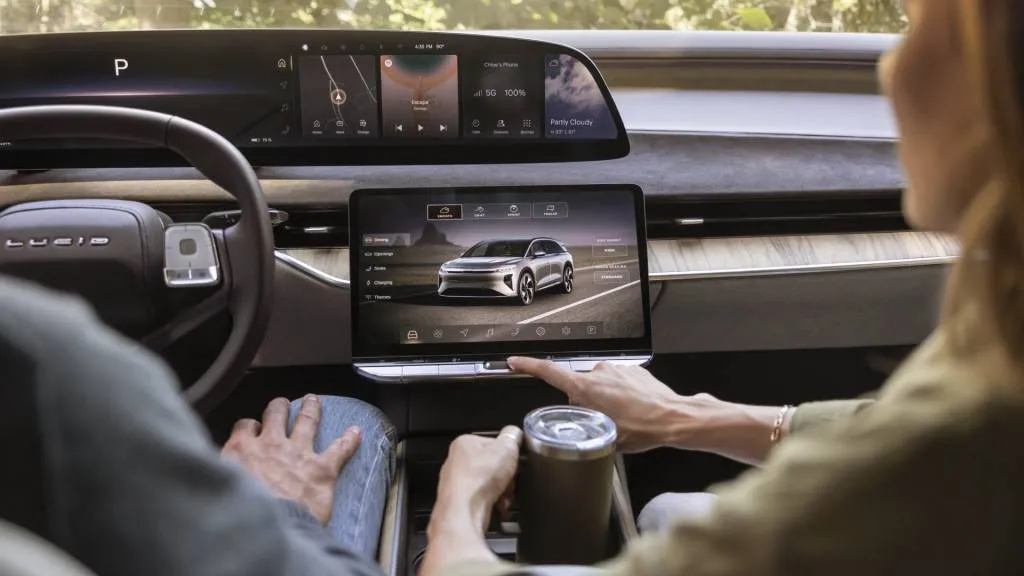
2025 Lucid Gravity Grand Touring

2025 Lucid Gravity Grand Touring
Indeed, in its 2025 Lucid Gravity SUV, which has a revamped interface, the automaker is offering a digital detox mode that goes with minimalist displays, and there’s a set of mood-and-ambience modes called Vibes. As Flint hinted, be prepared for voice controls to continue to take center stage there and beyond.
And among all of today’s AI hallucinations, observing that digital detox in voice form too might help drivers simply stay focused on what matters.
